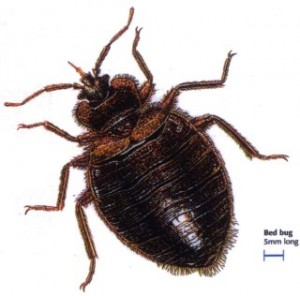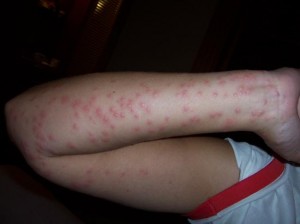Just when you thought it was safe at home bed bugs Invade
November 8, 2012 by admin
Filed under Home Maintenance, Pest Control
About bedbugs
Bedbugs look a bit like lentils. They are oval-shaped, flat and reddish-brown, and up to 5mm long.
Females lay 200-500 eggs over a two-month period. These white specks stick to surfaces and are very difficult to spot. They hatch to form tiny straw-coloured insects that take about six to eight weeks to grow into adults. As they grow, they shed their skin. This looks like mottled brown shells on your mattress.
Bedbugs need to feed on blood to be able to mature, but they are very resilient. Adults can survive for up to a year without feeding.
They are not attracted to dirt, so a bedbug infestation is not a sign of an unclean home.
How to spot them
Look for any unexplained skin rash or itchy bump (not everyone develops this though).
Look out for black spots on your mattress. This could be their dried faeces.
Look for mottled shells that bedbugs may have shed.
Check your sheets for blood spots where you may have rolled over and squashed a bug just after it had fed.
Inspect all the crevices and joints of your mattress and furniture using a torch, and see if you can spot any bugs.
https://www.nhs.uk/conditions/bed-bugs/Pages/Introduction.aspx
You should treat all affected areas and those immediately surrounding the bed as well as any other areas where bed bug activity has been noticed. In addition, activating Foggers or Smoke Bombs will help fumigate the area, and hard-to-reach areas can be tackled with an aerosol spray. Depending upon the extent of activity, repeat applications may be necessary at two-weekly intervals.
Highly recommended are our Bed Bug Killer Kits, which contain a number of products including a Bed Bug Killer Spray, Bed Bug Killer Powder, Foggers or Bed Bug Spray, along with an advice sheet giving step-by-step instructions on how to carry out a professional bed bug treatment.
To carry out a professional bed bug treatment, please follow the procedure outlined below:
1. Remove pets (including fish in fish tanks) from any rooms that are to be treated and keep them out until all treated surfaces have dried.
2. All items surrounding the bed should be moved to provide a clear area, and inspected for bed bug activity.
3. The affected beds should be stripped of all bedding and washed on the hottest temperature possible, without causing damage.
4. Any affected items found during the clearing process should either be washed on a high temperature, treated with insecticide or, if heavily infested, disposed of. (Do not treat clothing or animal bedding).
5. Inspect the mattress, paying particular attention to the edges where stitching appears. Also check around and underneath buttons if your mattress has these. Lightly apply spray to any affected areas, taking care not to soak the mattress. Allow to dry thoroughly before replacing bedding.
6. If your bed is a divan with drawers, remember to check inside these, ideally removing them to inspect and treat if necessary. Divan beds normally have a hessian/plastic cover on the base, please check around the edges of this for bed bugs and treat with spray.
7. If your bed has slats, please remove these for inspection as they often have bed bugs living between them and the frame of the bed. If your bed has a headboard, always check this as this is a common area where bed bugs are often found. Apply spray to these areas.
8. Be sure to inspect and treat along the edges of carpeted rooms, paying particular attention to the area around the bed. Inspect the inside of and bases of nearby furniture, including bedside tables/chests of drawers and, if possible, wardrobes. Apply spray to any areas where there are signs of infestation.
9. As bed bugs generally avoid daylight and lay their eggs in cracks and crevices, in addition to all the above, please inspect any other similar areas, treating accordingly.
10. Spray should be used in hard to reach areas the fine mist aerosol will penetrate better than the trigger spray.
11. As spray leaves a residue that is effective for a number of weeks following application, try not to clean for a short while after treatment as this will remove the insecticide, or alternatively reapply the spray after cleaning.
DO NOT apply any liquids directly to any electrical items or sources, being sure to avoid plug sockets, cables etc. Insecticidal dusts can be applied with caution around these areas.
12. Once the spray has been applied, activate Fogger following the directions on the canister. Leave the room for approx 3 hours and then to allow the gas to disperse, you should open windows and doors as this will ventilate the room and allow the insecticide to dry quicker.
13. Powder should be applied to divan bases, bed frames and floor area around bed. Powder will adhere better if surfaces are slightly damp; however, to avoid the powder congealing, carpets should be allowed to dry thoroughly before applying. DO NOT APPLY DIRECTLY TO MATTRESSES. Please ensure pets and/or children are kept away from treated area until powder has been removed.
15. Bed bugs are perhaps the most difficult of pests to treat. Their almost flat shape enables them to fit into the smallest of cracks and gaps, which means that thorough application is always essential in order to obtain control.


